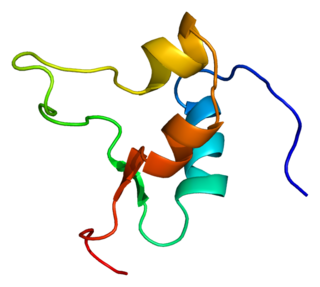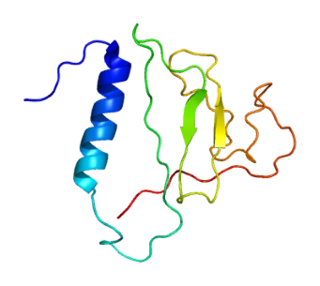
The insulin-like growth factors (IGFs) are proteins with high sequence similarity to insulin. IGFs are part of a complex system that cells use to communicate with their physiologic environment. This complex system consists of two cell-surface receptors, two ligands, a family of seven high-affinity IGF-binding proteins, as well as associated IGFBP degrading enzymes, referred to collectively as proteases.

Colostrum, or first milk, is the first form of milk produced by the mammary glands of humans and other mammals immediately following delivery of the newborn. It may be called beestings when referring to the first milk of a cow or similar animal. Most species will begin to generate colostrum just prior to giving birth. Colostrum has an especially high amount of bioactive compounds compared to mature milk to give the newborn the best possible start to life. Specifically, colostrum contains antibodies to protect the newborn against disease and infection, and immune and growth factors and other bioactives that help to activate a newborn's immune system, jumpstart gut function, and seed a healthy gut microbiome in the first few days of life. The bioactives found in colostrum are essential for a newborn's health, growth and vitality. Colostrum strengthens a baby's immune system and is filled with white blood cells to protect it from infection.

Insulin-like growth factor 1 (IGF-1), also called somatomedin C, is a hormone similar in molecular structure to insulin which plays an important role in childhood growth, and has anabolic effects in adults.

Insulin-like growth factor 2 (IGF-2) is one of three protein hormones that share structural similarity to insulin. The MeSH definition reads: "A well-characterized neutral peptide believed to be secreted by the liver and to circulate in the blood. It has growth-regulating, insulin-like and mitogenic activities. The growth factor has a major, but not absolute, dependence on somatotropin. It is believed to be a major fetal growth factor in contrast to insulin-like growth factor 1 (IGF-1), which is a major growth factor in adults."

The insulin-like growth factor 1 (IGF-1) receptor is a protein found on the surface of human cells. It is a transmembrane receptor that is activated by a hormone called insulin-like growth factor 1 (IGF-1) and by a related hormone called IGF-2. It belongs to the large class of tyrosine kinase receptors. This receptor mediates the effects of IGF-1, which is a polypeptide protein hormone similar in molecular structure to insulin. IGF-1 plays an important role in growth and continues to have anabolic effects in adults – meaning that it can induce hypertrophy of skeletal muscle and other target tissues. Mice lacking the IGF-1 receptor die late in development, and show a dramatic reduction in body mass. This testifies to the strong growth-promoting effect of this receptor.

The insulin-like growth factor-binding protein (IGFBP) serves as a transport protein for insulin-like growth factor 1 (IGF-1).

Insulin-like growth factor 2 receptor (IGF2R), also called the cation-independent mannose-6-phosphate receptor (CI-MPR) is a protein that in humans is encoded by the IGF2R gene. IGF2R is a multifunctional protein receptor that binds insulin-like growth factor 2 (IGF2) at the cell surface and mannose-6-phosphate (M6P)-tagged proteins in the trans-Golgi network.
Pappalysin-1, also known as pregnancy-associated plasma protein A, and insulin-like growth factor binding protein-4 protease is a protein encoded by the PAPPA gene in humans. PAPPA is a secreted protease whose main substrate is insulin-like growth factor binding proteins. Pappalysin-1 is also used in screening tests for Down syndrome.

Insulin-like growth factor-binding protein 3, also known as IGFBP-3, is a protein that in humans is encoded by the IGFBP3 gene. IGFBP-3 is one of six IGF binding proteins that have highly conserved structures and bind the insulin-like growth factors IGF-1 and IGF-2 with high affinity. IGFBP-7, sometimes included in this family, shares neither the conserved structural features nor the high IGF affinity. Instead, IGFBP-7 binds IGF1R, which blocks IGF-1 and IGF-2 binding, resulting in apoptosis.

Insulin-like growth factor-binding protein 2 is a protein that in humans is encoded by the IGFBP2 gene.

Insulin-like growth factor-binding protein 5(IBF-5) is a protein that in humans is encoded by the IGFBP5 gene. An IGFBP5 gene was recently identified as being important for adaptation to varying water salinity in fish.

Insulin-like growth factor-binding protein 4 is a protein that in humans is encoded by the IGFBP4 gene.

Insulin-like growth factor-binding protein 6 (IGFBP-6) is a protein that in humans is encoded by the IGFBP6 gene.

Insulin-like growth factor-binding protein 1 (IBP-1) also known as placental protein 12 (PP12) is a protein that in humans is encoded by the IGFBP1 gene.

Insulin-like growth factor-binding protein 7 is a protein that in humans is encoded by the IGFBP7 gene. The major function of the protein is the regulation of availability of insulin-like growth factors (IGFs) in tissue as well as in modulating IGF binding to its receptors. IGFBP7 binds to IGF with low affinity compared to IGFBPs 1-6. It also stimulates cell adhesion. The protein is implicated in some cancers.

Insulin-like growth factor binding protein, acid labile subunit, also known as IGFALS, is a protein which in humans is encoded by the IGFALS gene.
Mecasermin, sold under the brand name Increlex, also known as recombinant human insulin-like growth factor-1 (rhIGF-1), is a recombinant form of human insulin-like growth factor 1 (IGF-I) which is used in the long-term treatment of growth failure and short stature in children with severe primary IGF-I deficiency, for instance due to growth hormone deficiency or Laron syndrome.

Anamorelin (INN), also known as anamorelin hydrochloride, is a non-peptide, orally-active, centrally-penetrant, selective agonist of the ghrelin/growth hormone secretagogue receptor (GHSR) with appetite-enhancing and anabolic effects which is under development by Helsinn Healthcare SA for the treatment of cancer cachexia and anorexia.
Long arginine 3-IGF-1, abbreviated as IGF-1 LR3 or LR3-IGF-1, is a synthetic protein and lengthened analogue of human insulin-like growth factor 1 (IGF-1). It differs from native IGF-1 in that it possesses an arginine instead of a glutamic acid at the third position in its amino acid sequence, and also has an additional 13 amino acids at its N-terminus (MFPAMPLLSLFVN) ("long"), for a total of 83 amino acids. The consequences of these modifications are that IGF-1 LR3 retains the pharmacological activity of IGF-1 as an agonist of the IGF-1 receptor, has very low affinity for the insulin-like growth factor-binding proteins (IGFBPs), and has improved metabolic stability. As a result, it is approximately three times more potent than IGF-1, and possesses a significantly longer half-life of about 20–30 hours.
des(1-3)IGF-1 is a naturally occurring, endogenous protein, as well as drug, and truncated analogue of insulin-like growth factor 1 (IGF-1). des(1-3)IGF-1 lacks the first three amino acids at the N-terminus of IGF-1. As a result of this difference, it has considerably reduced binding to the insulin-like growth factor-binding proteins (IGFBPs) and enhanced potency relative to IGF-1.
















